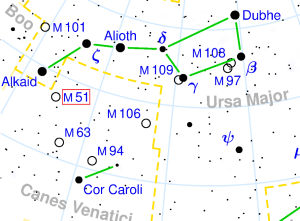The Whirlpool Galaxy, also known as Messier 51 (M51) and NGC 5194, is a grand-design spiral galaxy in Canes Venatici. The galaxy appears face-on when seen from Earth. Its designation in the New General Catalogue is NGC 5194. The galaxy lies about 23 million light years from Earth. It was named the Whirlpool because of its swirling spiral structure.
The Whirlpool Galaxy is one of the brightest and most famous galaxies in the night sky, notable for its two striking spiral arms that make M51 a grand design galaxy. The spiral arms are really lanes of stars and starburst regions interspersed with dust. They compress hydrogen gas and are responsible for creating new clusters of stars.
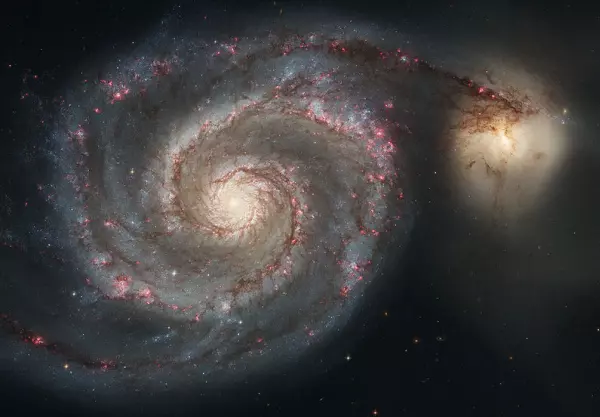
Whirpool Galaxy (Messier 51), photo: NASA, ESA, S. Beckwith (STScI), and The Hubble Heritage Team STScI, AURA)
Messier 51 is gravitationally interacting with a smaller dwarf galaxy, NGC 5195, and the two make one of the best known pairs of interacting galaxies in the sky.
NGC 5195 has been gliding past the larger galaxy for hundreds of millions of years and its shape is highly distorted, making classification difficult. It has been identified as an amorphous or irregular galaxy and sometimes classified as a lenticular galaxy.
The face-on view and relative proximity to Earth make the two galaxies relatively easy to find and observe, even for amateur astronomers. The galaxy pair can even be seen with binoculars.
The Whirlpool Galaxy (NGC 5194) is sometimes referred to as Messier 51a, while NGC 5195 is often called Messier 51b. The designation Messier 51 is used to refer either to the Whirlpool or to both galaxies. The bigger galaxy in particular is a popular target for astronomers, who observe and study it for the insight it provides into spiral arm structure and galaxy interactions.
The striking spiral structure of the Whirlpool Galaxy is thought to be the result of its close interaction with the smaller NGC 5195. The interaction between the pair also results in compression of hydrogen gas which in turn leads to formation of starburst regions, seen in pictures as bright blue knots across the galaxy’s spiral arms.
FACTS, LOCATION AND SIZE
The Whirlpool Galaxy was first observed by Charles Messier on October 13, 1773, when he was observing a comet. He later added the object to his catalogue as Messier 51. The smaller galaxy, NGC 5195, was discovered by Messier’s colleague Pierre Méchain in 1781.
Charles Messier originally described the object as a “very faint nebula, without stars, near the eye of the Northern Greyhound, below the star Eta of 2nd magnitude of the tail of Ursa Major… One cannot see this nebula without difficulties with an ordinary 3.5 foot telescope. Near it is a star of 8th magnitude.” After the discovery of the smaller companion galaxy, he noted, “It is double, each has a bright centre, which are separated 4’35”. The two ‘atmospheres’ touch each other, the one is even fainter than the other.”
The Whirlpool galaxy was the first galaxy to be recognized as a spiral, in spring 1845, after William Parsons, the 3rd Earl of Rosse, observed it with his 72-inch reflector, the so-called Leviathan. Lord Rosse also created a very accurate painting of the object, which is why Messier 51 is sometimes also called Rosse’s Galaxy or Lord Rosse’s ‘Question Mark.’
The Whirlpool Galaxy is relatively easy to find in good observing conditions. It lies just below Alkaid, Eta Ursae Majoris, the bright star marking the tip of the handle of the Big Dipper in Ursa Major constellation. It can be found by moving the binoculars to the southwest of Alkaid, toward Cor Caroli, Alpha Canum Venaticorum, the brightest star in Canes Venatici constellation. The Whirlpool Galaxy is located 3.5° to the southeast of Alkaid. It is best viewed at a low magnification and, to make out the spiral arms, one needs at least a 4-inch telescope.
The Whirlpool Galaxy is approximately 60 light years across. It has an angular diameter of about 11.2′. The galaxy’s bright circular disk is believed to have a radius of approximately 43,000 light years. The estimated mass of M51 is about 160 billion solar masses.
The galaxy’s compact nucleus is classified as of Seyfert type 2.5. The declination of the galaxy is +47°, which makes M51 circumpolar (never setting below the horizon) for observers above 43°N latitude.
With a diameter of approximately 75,000 light years, the Whirlpool is about 25 percent smaller than our own galaxy, the Milky Way. The angular diameter of the galaxy is about 1/3rd the width of the full Moon.
In good viewing conditions, the Whirlpool Galaxy can be seen with binoculars, and with amateur telescopes it can be observed in greater detail. The outlines of the Whirlpool and its companion galaxy are visible through a 100 mm telescope, and the spiral structure can be seen though a 150 mm telescope. To see the galaxy’s spiral bands and HII regions, one needs a larger instrument, ideally one of more than 300 mm.
Three supernovae have been observed in the galaxy. SN 1994I was spotted on April 2, 1994. It peaked at magnitude 12.8 and was classified as a type Ic supernova. SN 2005cs, a type II supernova was seen on June 27, 2005, and peaked at visual magnitude 14. SN 2011dh was detected on May 31, 2011. It had an apparent visual magnitude of 14.2, peaked at magnitude 13.5, and was classified as a type II supernova.
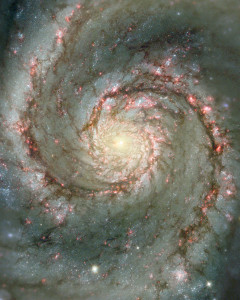
The Whirlpool Galaxy, also known as M51 or NGC 5194, is having a close encounter with a nearby companion galaxy, NGC 5195, just off the upper edge of this image. The companion’s gravitational pull is triggering star formation in the main galaxy, as seen in brilliant detail by numerous, luminous clusters of young and energetic stars. The bright clusters are highlighted in red by their associated emission from glowing hydrogen gas. This Wide Field Planetary Camera 2 image enables researchers to clearly define the structure of both the cold dust clouds and the hot hydrogen and link individual clusters to their parent dust clouds. Intricate structure is also seen for the first time in the dust clouds. Along the spiral arms, dust “spurs” are seen branching out almost perpendicular to the main spiral arms. Image: NASA and The Hubble Heritage Team (STScI/AURA)
The central region of the Whirlpool Galaxy is undergoing a period of intense star formation at a rate it will likely not be able to sustain for more than another 100 million years. In NGC 5195, however, there are almost no new stars being formed. This means that the smaller galaxy was either dust-poor even before the encounter with the Whirlpool or it has been stripped of dust as a result of the interaction with the larger galaxy.
The Whirlpool Galaxy and NGC 5195 had not been confirmed to be interacting until the first radio images of the pair were obtained. Prior to that, astronomers could not determine with any degree of certainty that the two galaxies were not just lying in the same line of sight.
Both NGC 5194 and NGC 5195 are believed to contain supermassive black holes, each emitting intense X-rays.
The current spiral structure of the larger galaxy is believed to be a result of the smaller galaxy passing through its main disk some 500 to 600 million years ago and making another crossing about 50 to 100 million years ago. NGC 5195 is now located slightly behind the Whirlpool Galaxy.
The two galaxies are gravitationally bound and approaching each other for another interaction. They will eventually merge, but not before they have made a few more passes, which will likely take hundreds of millions of years.
The Whirlpool Galaxy is the brightest member of the M51 Group, a group of galaxies that includes several notable members located in the same region of the sky: the Sunflower Galaxy (Messier 63), NGC 5023, NGC 5229, UGC 8313, and UGC 8331.
CROSS
The nucleus of Messier 51 contains a cross, or an X-structure, which suggests that the galaxy has two dust rings surrounding the central black hole.
One of the dust rings stands almost perpendicular to the relatively flat spiral galaxy, and the other ring crosses the first one on a different axis. Two ionization cones stretch from the axis of the primary dust ring.
The dark “X” appears silhouetted across the M51’s nucleus and is believed to reveal the exact location of the galaxy’s central black hole and to be a result of absorption by dust. The darker bar could be a dust ring about 100 light years in diameter, appearing edge-on. The other of the two bars forming the “X” may be either another disk, also seen edge-on, or just rotating dust and gas crossing paths with the ionization cones and jets.
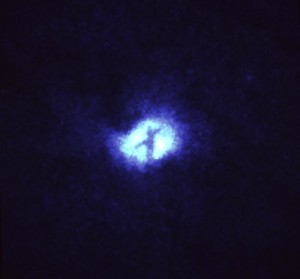
This image of the core of the nearby spiral galaxy M51, taken with the Wide Field Planetary camera (in PC mode) on NASA’s Hubble Space Telescope, shows a striking , dark “X” silhouetted across the galaxy’s nucleus. Image: H. Ford (JHU/STScI), the Faint Object Spectrograph IDT, and NASA – Hubblesite
The X-structure was revealed in an image taken by NASA’s Hubble Space Telescope, with Dr. Holland Ford of the Johns Hopkins University and Space Telescope Science Institute and his team reporting the following observations:
“Pictures of M51 taken with the [Hubble] Planetary Camera show a striking, dark ‘X’ silhouetted across the nucleus. The ‘X’ is due to absorption by dust and marks the exact position of the nuclear black hole. If these ideas are correct, M51 provides the first direct view of a torus [ring] which both fuels a massive black hole and hides the hole from direct view from anyone outside the ionization cone [narrow cone of light emitted from the near-vicinity of the black hole].”
Whirlpool Galaxy – Messier 51 (NGC 5194)
Constellation: Canes Venatici, the Hunting Dogs
Galaxy type: SA(s)bc pec
Coordinates: 13h29m52.7s (right ascension), +47°11’43” (declination)
Distance: 23 ± 4 million light years (7.1 ± 1.2 megaparsecs)
Redshift: 463 ± 3 kilometres per second
Apparent dimensions: 11.2 x 6.9 arc minutes
Diameter: 75,000 light years
Visual magnitude: 8.4
Designations: Whirlpool Galaxy, Messier 51 (M51), Messier 51a (M51a), Rosse’s Galaxy, Question Mark Galaxy, NGC 5194, UGC 8493, Arp 85, PGC 47404, GC 3572, VV 001a, VV 403
IMAGES
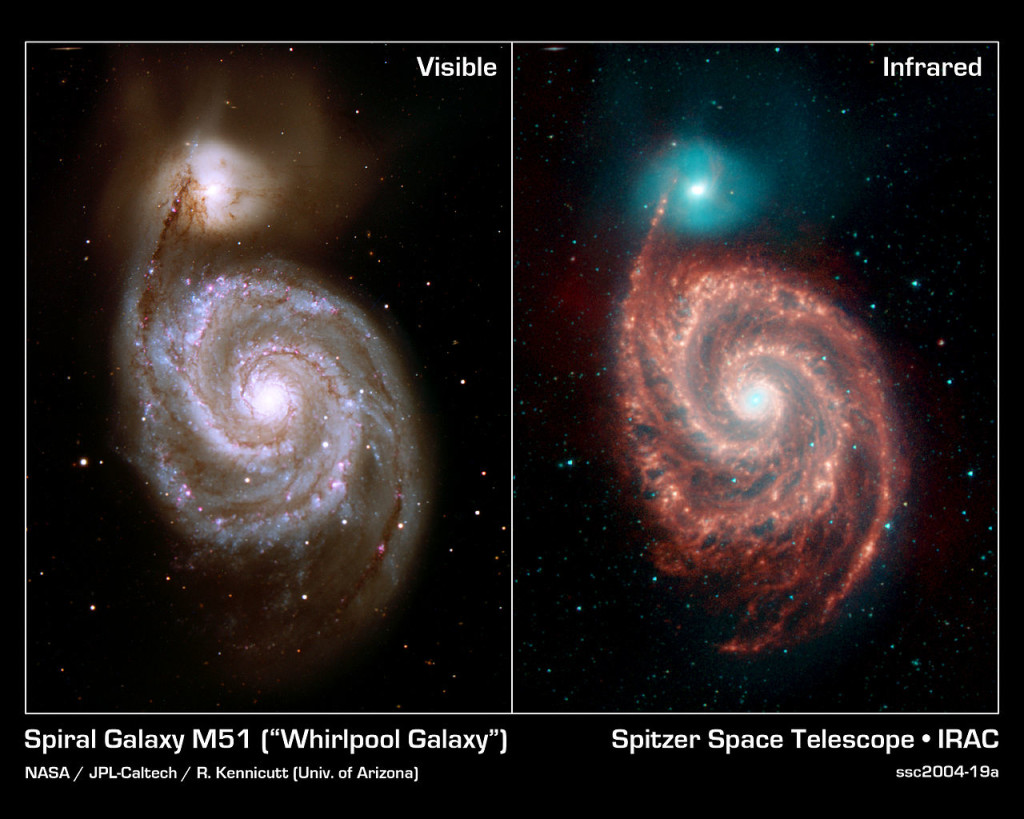
NASA’s Spitzer Space Telescope has captured these infrared images of the “Whirlpool Galaxy,” revealing strange structures bridging the gaps between the dust-rich spiral arms, and tracing the dust, gas and stellar populations in both the bright spiral galaxy and its companion. The Spitzer image is a four-color composite of invisible light, showing emissions from wavelengths of 3.6 microns (blue), 4.5 microns (green), 5.8 microns (orange) and 8.0 microns (red). These wavelengths are roughly 10 times longer than those seen by the human eye. The visible light image comes from the Kitt Peak National Observatory 2.1m telescope, and has the same orientation and size as the Spitzer infrared image, measuring 9.9 by 13.7 arcminutes (north up). Also a four-color composite, the visible light image shows emissions from 0.4 to 0.7 microns, including the H-alpha nebular feature (red in the image). The light seen in the images originates from very different sources. At shorter wavelengths (in the visible bands, and in the infrared from 3.6 to 4.5 microns), the light comes mainly from stars. This starlight fades at longer wavelengths (5.8 to 8.0 microns), where we see the glow from clouds of interstellar dust. This dust consists mainly of a variety of carbon-based organic molecules known collectively as polycyclic aromatic hydrocarbons. Wherever these compounds are found, there will also be dust granules and gas, which provide a reservoir of raw materials for future star formation. Particularly puzzling are the large number of thin filaments of red emission seen in the infrared data between the arms of the large spiral galaxy. In contrast to the beady nature of the dust emission seen in the arms themselves, these spoke-like features are thin and regular, and prevalent in the gaps all over the face of the galaxy. Also of interest is the contrast in the distributions of dust and stars between the spiral and its faint companion. While the spiral is rich in dust, bright in the longer infrared wavebands, and actively forming new stars, its blue companion shows little infrared emission and hosts an older stellar population. The spectacular whirlpool structure and star formation in M51 are thought to be triggered by an ongoing collision with its companion. Understanding the impact on star formation by the interaction of galaxies is one of the goals of these observations. Image: NASA/JPL-Caltech/R. Kennicutt (Univ. of Arizona)/DSS
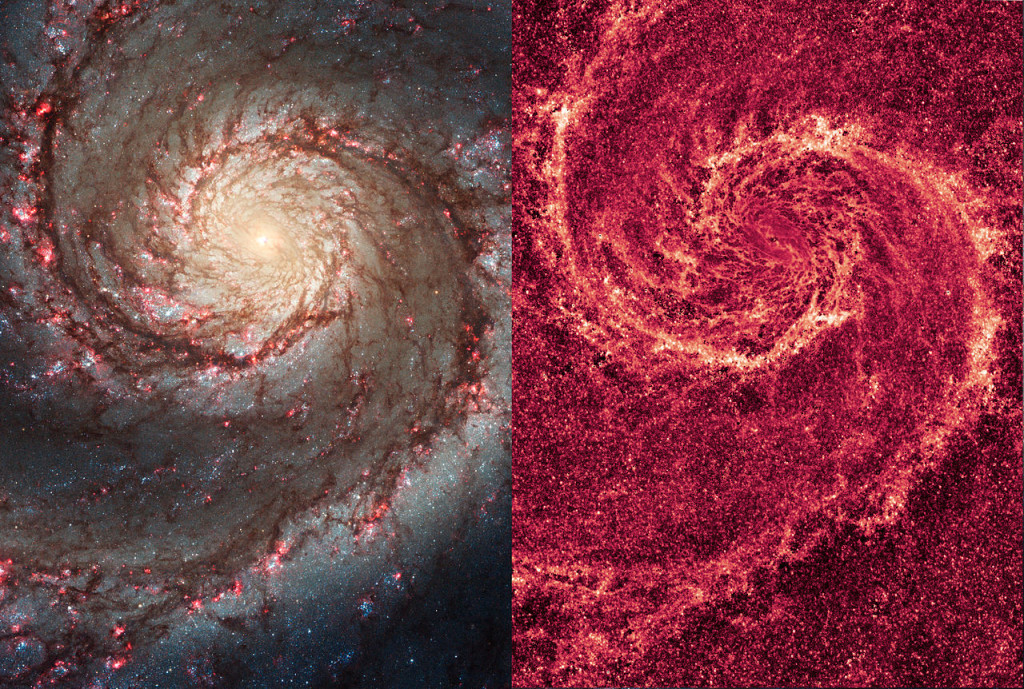
These images by NASA’s Hubble Space Telescope show off two dramatically different face-on views of the spiral galaxy M51, dubbed the Whirlpool Galaxy. The image at left, taken in visible light, highlights the attributes of a typical spiral galaxy, including graceful, curving arms, pink star-forming regions, and brilliant blue strands of star clusters. In the image at right, most of the starlight has been removed, revealing the Whirlpool’s skeletal dust structure, as seen in near-infrared light. This new image is the sharpest view of the dense dust in M51. The narrow lanes of dust revealed by Hubble reflect the galaxy’s moniker, the Whirlpool Galaxy, as if they were swirling toward the galaxy’s core. To map the galaxy’s dust structure, researchers collected the galaxy’s starlight by combining images taken in visible and near-infrared light. The visible-light image captured only some of the light; the rest was obscured by dust. The near-infrared view, however, revealed more starlight because near-infrared light penetrates dust. The researchers then subtracted the total amount of starlight from both images to see the galaxy’s dust structure. The red colour in the near-infrared image traces the dust, which is punctuated by hundreds of tiny clumps of stars, each about 65 light-years wide. These stars have never been seen before. The star clusters cannot be seen in visible light because dense dust enshrouds them. The image reveals details as small as 35 light-years across. Image – Infrared: NASA, ESA, M. Regan & B. Whitmore (STScI), & R. Chandar (U. Toledo);Optical: NASA, ESA, S. Beckwith (STScI), & the Hubble Heritage Team (STScI/AURA)
